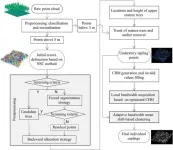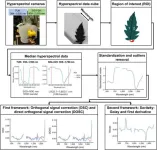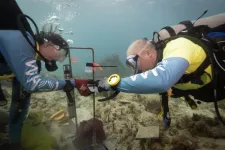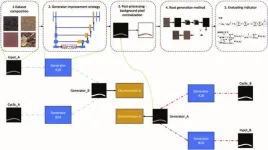(Press-News.org) When we daydream, we must be able to snap back to attention at a moment’s notice. Researchers at Boston Children’s Hospital uncovered how our brains can do things like react to a question when we’re daydreaming: firing activity in part of the brain called the dentate gyrus keeps us focused on what’s happening in our environment. And the team found that the same neural activity also helps with forming memories. The findings were published in Nature on March 13, 2024.
“We have found a brain mechanism for breaking up periods of mind wandering and realigning the ‘cognitive map’ back to reality,” says Jordan Farrell, PhD, an investigator in the F.M. Kirby Neurobiology Center and Rosamund Stone Zander Translational Neuroscience Center at Boston Children’s.
It’s known that during sleep or periods of daydreaming, our brains replay past events in a form of synchronized activity known as the “sharp-wave ripple.” This enables us to consolidate our memories.
Analyzing data from a mouse model, Farrell and colleagues from the laboratory of Ivan Soltesz, PhD, at Stanford University began exploring another, little-known neuronal activity pattern: synchronized spikes of firing in the dentate gyrus, part of the hippocampus. These spikes, they found, occur when an “offline” brain is aroused. They may help us quickly process new information and orient ourselves to what’s happening in our environment.
But dentate spikes also seem to promote associative memory — in which a sensory stimulus (say, a series of loud beeps) is stored as a memory, so that we come to associate the noise with a smoke alarm going off and the possible need to evacuate.
Sharp-wave ripples and dentate spikes may have complementary roles, Farrell says. “The brain is toggling through these two states.”
This new knowledge about dentate spikes could open windows into some neuropsychiatric disorders. Perhaps dentate spikes affect attention and arousal in people with attention-deficit/hyperactivity disorder or post-traumatic stress disorder. Or maybe they are altered in Alzheimer’s disease, disrupting formation of new memories.
Farrell is most interested in epilepsy, which is marked by synchronized spikes of excessive neuron firing. He plans to investigate the role of dentate spikes by better understanding their basic mechanisms and then manipulating the neural networks that control dentate spikes in the brains of epileptic mice. He also hopes to extend the study to children with epilepsy, in collaboration with clinicians at Boston Children’s.
“In people with epilepsy, the synchronous activity during dentate spikes could tip the brain into a pathological state,” Farrell speculates. “The dentate spikes add an extra push to the system.”
END
How the brain wakes us from daydreams
Researchers at Boston Children’s Hospital discover that activity in the dentate gyrus keeps us focused on our environment when our mind wanders
2024-03-13
ELSE PRESS RELEASES FROM THIS DATE:
Revolutionizing forest management: unveiling understory saplings with advanced airborne LiDAR technology
2024-03-13
The regeneration of forest saplings is pivotal for maintaining biodiversity and ecosystem productivity, necessitating innovative management techniques for continuous forest coverage. Traditional 2-dimensional remote sensing struggles to accurately capture the complex, understory sapling dynamics. To address this, researchers are exploring the use of aerial laser scanning (ALS) for its potential in providing detailed 3-dimensional insights. However, despite progress in using ALS data to estimate tree metrics, accurately identifying and quantifying the phenotypic ...
High resolution imagery advances the ability to monitor decadal changes in emperor penguin populations
2024-03-13
Woods Hole, Mass. (March 13, 2024) - Emperor penguin populations have been exceedingly difficult to monitor because of their remote locations, and because individuals form breeding colonies on seasonal sea ice fastened to land (known as fast ice) during the dark and cold Antarctic winter.
Now, new research that incorporates very high resolution (VHR) satellite imagery with field-based validation surveys and long-term data has provided the first multi-year time series that documents emperor penguin global population trends.
Researchers ...
Gilbert H. L. Tang appointed Editor-in-Chief of JACC: Case Reports
2024-03-13
Renowned cardiovascular surgeon Gilbert H. L. Tang has been named Editor-in-Chief of JACC: Case Reports, bringing a wealth of experience and expertise to the helm of one of the top cardiovascular journals published by the American College of Cardiology.
“I am both honored and humbled to be a cardiac surgeon among the Editor-in-Chiefs in the JACC family of journals,” Tang said. “It is going to be an exciting time for JACC: Case Reports to build on a team of multidisciplinary cardiovascular practitioners with diverse backgrounds and experiences, and at different stages of their professional careers, to enhance the journal’s academic and educational impact globally.”
Tang ...
Enhancing crop nutritional analysis: a leap towards precision agriculture with multi-target regression and hyperspectral imaging
2024-03-13
Recent advancements in hyperspectral imaging and machine learning have revolutionized the non-destructive monitoring of crop nutritional status, enabling accurate prediction of plant element concentrations. Despite successes, the single-target regression method, which predicts concentrations individually, faces accuracy limitations for certain elements. Traditional methods offer accuracy but at the cost of being destructive and inefficient for large-scale use. Current research highlights the potential of multi-target ...
Sonic youth: Healthy reef sounds increase coral settlement
2024-03-13
Woods Hole, Mass. – A healthy coral reef is noisy, full of the croaks, purrs, and grunts of various fishes and the crackling of snapping shrimp. Research suggests that larval animals use this symphony of sounds to help them determine where they should live and grow.
Researchers at the Woods Hole Oceanographic Institution (WHOI) recently demonstrated that replaying healthy reef sounds could potentially be used to encourage coral larvae to recolonize damaged or degraded reefs. A reef that has been ...
Warwick awarded £11 million to train PhD students in computational modelling
2024-03-13
The University of Warwick has been awarded £11m to train PhD students in computational modelling.
The new centre will train 50 PhD students to use computational modelling to tackle pressing global sustainability challenges from accessing clean fusion energy, controlling infectious diseases, to designing energy-efficient devices such as new battery electrolytes.
The Centre for Doctoral Training in Modelling of Heterogeneous Systems (HetSys II), led by Professor James Kermode from the School of Engineering, Dr Livia Bartok-Partay from Chemistry and Professor Nicholas Hine from Physics, will train ...
Simple trick could improve accuracy of plant genetics research
2024-03-13
Researchers have published a simple trick that improves the accuracy of techniques that help us understand how external variables – such as temperature – affect gene activity in plants.
“There are really two contributions here,” says Colleen Doherty, corresponding author of a paper on the work and an associate professor of molecular and structural biochemistry at North Carolina State University. “First, we’re raising the visibility of a problem that many of us in the ...
Revolutionizing plant science: a groundbreaking method for expanding in situ root datasets using CycleGAN
2024-03-13
The root system is crucial for plants to absorb water and nutrients, with in situ root research providing insights into root phenotypes and dynamics. While deep-learning-based root segmentation methods have advanced the analysis of root systems, they require extensive manually labeled datasets, which are labor-intensive and time-consuming to produce. Current methods of in situ root observation vary in their effectiveness. Moreover, traditional root image recognition methods face challenges such as subjectivity and ...
COVID-19 rebound after VV116 vs nirmatrelvir-ritonavir treatment
2024-03-13
About The Study: In this randomized clinical trial of 345 patients with mild-to-moderate COVID-19, viral load rebound and symptom rebound were both common after a standard 5-day course of antiviral treatment with either VV116 or nirmatrelvir-ritonavir. Prolongation of treatment duration might be investigated to reduce COVID-19 rebound.
Authors: Yufang Bi, M.D., and Yiping Xu, M.Sc., of the Shanghai Jiao Tong University School of Medicine in Shanghai, China, are the corresponding authors.
To access the embargoed study: Visit our For ...
Mental well-being among adversity-exposed adolescents during the pandemic
2024-03-13
About The Study: The findings of this study of 4,515 adolescents suggest that in-person schooling and several coping behaviors (caring for one’s body, exercising, and engaging in healthy behaviors) were associated with significantly higher positive affect and lower perceived stress during the COVID-19 pandemic among adolescents with high adverse childhood experiences (ACEs). Adolescents with high ACEs demonstrated especially greater mental health scores when they reported in-person schooling. Future studies should build on these findings to identify clinical and school-based mental health protective ...
LAST 30 PRESS RELEASES:
Norbert Holtkamp appointed director of Fermi National Accelerator Laboratory
New agentic AI platform accelerates advanced optics design
Biologists discover neurons use physical signals — not electricity — to stabilize communication
Researchers discover that a hormone can access the brain by hitchhiking
University of Oklahoma researcher awarded funding to pursue AI-powered material design
Exploring how the visual system recovers following injury
Support for parents with infants at pediatric check-ups leads to better reading and math skills in elementary school
Kids’ behavioral health is a growing share of family health costs
Day & night: Cancer disrupts the brain’s natural rhythm
COVID-19 vaccination significantly reduces risk to pregnant women and baby
The role of vaccination in maternal and perinatal outcomes associated with COVID-19 in pregnancy
Mayo Clinic smartwatch system helps parents shorten and defuse children's severe tantrums early
Behavioral health spending spikes to 40% of all children’s health expenditures, nearly doubling in a decade
Digital cognitive behavioral treatment for generalized anxiety disorder
Expenditures for pediatric behavioral health care over time and estimated family financial burden
Air conditioning in nursing homes and mortality during extreme heat
The Alps to lose a record number of glaciers in the next decade
What makes a good proton conductor?
New science reporting guide published for journalists in Bulgaria
New international study reveals major survival gaps among children with cancer
New science reporting guide published for journalists in Turkey
Scientists develop a smarter mRNA therapy that knows which cells to target
Neuroanatomy-informed brain–machine hybrid intelligence for robust acoustic target detection
Eight SwRI hydrogen projects funded by ENERGYWERX
The Lundquist Institute and its start-up company Vitalex Biosciences Announces Strategic Advancement of Second-Generation fungal Vaccine VXV-01 through Phase 1 Trials under $40 Million Competitive Con
Fine particles in pollution are associated with early signs of autoimmune disease
Review article | Towards a Global Ground-Based Earth Observatory (GGBEO): Leveraging existing systems and networks
Penn and UMich create world’s smallest programmable, autonomous robots
Cleveland researchers launch first major study to address ‘hidden performance killer’ in athletes
To connect across politics, try saying what you oppose
[Press-News.org] How the brain wakes us from daydreamsResearchers at Boston Children’s Hospital discover that activity in the dentate gyrus keeps us focused on our environment when our mind wanders





